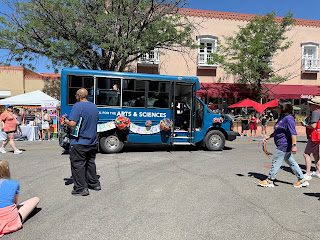If you had asked me a year ago whether public funding for the arts by City, State, or Federal Government was a good thing. I would have said, of course, it is. But. the situation has changed drastically and very quickly, at least from the Federal side.
Public funding for the arts can be justified on many grounds. As I have written several times in the past, it has been shown that just seeing art or listening to music has a calming effect and can help keep one healthy. Last month, I even wrote about doctors’ prescriptions for art.
https://www.geraldstiebel.com/2025/04/an-art-prescription.htmlActively engaging in the arts enhances education both by teaching discipline and encouraging creativity and innovation. We can also learn a lot about history through the arts of the past. Theater, movies and literature can bring the past alive. Also, the art created today acts as a time capsule for tomorrow. Both historic and contemporary arts play a crucial role in preserving cultural heritage and identity.
As a species, we have a need for collective interaction. We read so often that loneliness is on the rise because we are losing our ability to communicate directly, due to our absorption with all the technology we have at home. You have to admit that it is more exciting if you are in an audience with others and can share the experience rather than watching alone in front of your screen.

We cannot forget what the arts do for the economy. How many people are employed in a theater and the support thereof How many musicians play in a concert or orchestra. Movies and TV shows don’t just need actors. Have you ever followed the credits at the end of a film listing all individuals it took to put the movie together!? Contrary to the image of a lone painter in his studio he or she may have a back up team, an assistant, a publicist or a gallery that employs a number of people, including art handlers, packers and shippers. At the end of that line are the clients who purchase the art or buy tickets for the show.

What happens, however, when the government makes the decisions on what should be communicated, be it by the artist, the producer, or the editor? During the McCarthy era, when communists or left-leaning artists and intellectuals were considered the enemy, a professor teaching advanced mathematics was fired for his leftist political beliefs, though the latter had nothing to do with the former.
How much influence should a donor of any sort have on arts and educational organizations. Public schools are funded by governments because it is vital to any country to have an educated and functional population. But what happens when government gets involved in editing out parts of history such as slavery or the holocaust. Is it in the interest of a “Government of the people, by the people, for the people" to keep their constituents ignorant?
What happens when one individual or an administration, be it local or federal, has the power to dictate what we are allowed to learn or see or even create?
In China, today, there are severe restrictions on what can be portrayed in the arts. An artist who portrays anything that the government considers against its interests can be sanctioned, in some cases which can include a prison sentence.
In that situation, citizens cannot know about the ideas that were not being allowed, only what the government finds to be appropriate and in its interests.
Self-censorship will limit the creativity of artists who want to make a living from their art and the same will be true for arts organizations. It is easier to follow party lines and accept what someone else thinks you should enjoy or think. It is appropriate for a young child to be guided by parents and teachers, but in this country, we have been encouraged to question, explore, and expand our horizons beyond those limits. It has made us an admired world world-leading nation.
We are losing the ability to decide what we like or what is good or bad with our current administration’s desire to eliminate the NEA and the NEH and dictate what can be presented by government-funded organizations. I want to be able to have broad exposure and make my own judgments. It is not a question of good art or bad art, or right art or wrong art. This is an existential threat to art itself as all art comes from a creative process which involves free thinking and imagination without restraints.









































